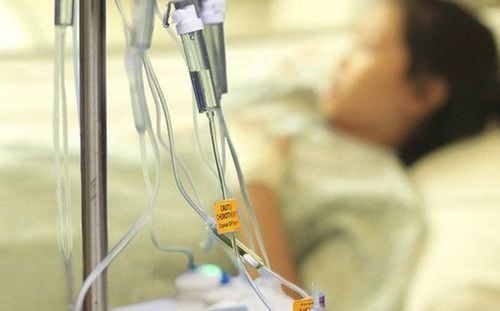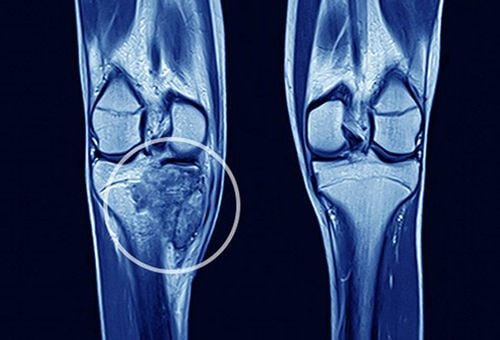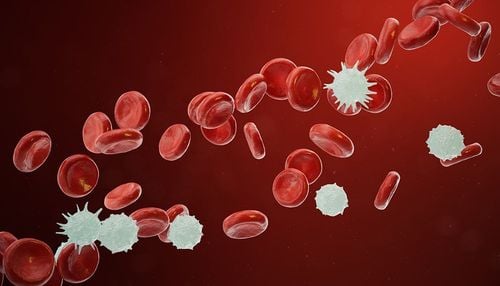This is an automatically translated article.
Bone cancer is rare, but its incidence is increasing, prompting doctors to warn. Severe illness often presents with obvious signs and symptoms, causing serious health problems, even life-threatening.1. What is bone cancer?
Connective bone cancer from 3 cells, including chondrocytes, osteoblasts and connective tissue of bone. This rare cancer is formed by the presence of a malignant tumor in the uterus, these tumors often grow very strongly and compete with healthy bone tissue, which can be life-threatening.
Bone cancer can be primary or secondary (metastasize from another place, such as lung, breast,...). However, in most cases the detection of cancer is secondary, because the disease often manifests itself in the late stages; only a few cases are primary.
Bone cancer usually occurs mainly in sites such as the tibia, femur, lower end of the radial bone, and the top of the humerus.
Trắc nghiệm: Thử hiểu biết của bạn về bệnh ung thư
Ung thư là nguyên nhân gây tử vong hàng thứ 2 trên thế giới. Thử sức cùng bài trắc nghiệm sau đây sẽ giúp bạn có thêm kiến thức về yếu tố nguy cơ cũng như cách phòng ngừa bệnh ung thư.
Bài dịch từ: webmd.com
2. Common types of bone cancer
Bone cancer usually has 3 main types, including:
Bone sarcoma : Usually occurs in bone-like tissue - a tissue that has a structure similar to bone, but it has less mineral content. The location of the cancer is usually the knee and arm; Cartilaginous sarcoma: Cancer in cartilage tissue, appearing mostly in places such as pelvis, femur and shoulder; Familial Ewing Sarcoma (ESFTs): Usually occurs in bone or soft tissue (muscle, fibrous, fatty tissue, blood vessels, or other supporting tissues). It usually occurs along the spine, pelvis, arms or legs.
3. Causes of bone cancer
It can be said that the main cause of bone cancer is a genetic disorder related to cell division with a mutated gene. Children at the age of bone development are the main subjects of the disease. Most are kids between the ages of 12 and 20.
Besides, there are a number of other causes leading to bone cancer, including:
Ionizing radiation: When exposed to a lot of ionizing rays during radiation therapy, it will lead to the change of cells. cells, causing bone cancer; Trauma: Bone cancer can also occur if it is hit hard or affected by external influences for a certain period of time.
4. What are the signs and symptoms of bone cancer?
Bone cancer includes 3 grades, which are mild, moderate and severe. At each stage, bone cancer signs and symptoms will be different. Often in the early stages, patients will find it difficult to detect the disease, because the symptoms are vague and unclear. At a severe level, the symptoms will be more pronounced, and the patient can be easily noticed. These symptoms include:
Pain: This is the first sign that can signal that the patient is at risk of bone cancer. In the early stages there will be only mild pain, intermittent pain. As the disease progresses, the frequency of attacks will gradually increase and become more frequent. Most often, the pain occurs at night, affecting the patient's sleep. However, it is difficult for you to pinpoint the exact location of the pain, because it happens so vaguely; Swelling or lump: In the early stages of the disease, when the tumor appears, you will feel the bone is deformed and swollen. When the swelling gets worse, the bone tissue will protrude, the surface is smooth or abnormally convex. These tumors cause pain and discomfort in the bones. The skin in the tumor is pink and warmer than other areas; Bone dysfunction: Swelling and pain seriously affect bone function, causing corresponding symptoms of muscle atrophy; Compression symptoms: Tumors growing in the skull and nasal cavity can put pressure on the brain and nose, leading to symptoms of sluggish brain pressure and some breathing problems. Tumor in the pelvic area that presses on the rectum, bladder and intestines, causing difficulty urinating; tumors in the spinal cord that press on the spine can cause paralysis; Deformed body: Strong growth of tumor will affect the limb skeletal system, causing deformities, body deformities, abnormal changes in the lower extremities; Fracture: the cancerous bone area when a strong impact is very easy to break, which can cause paralysis of the leg; Body aches: There are signs such as difficulty sleeping, loss of appetite, listlessness, paleness, sudden weight loss,...;. Severe body weakness: Patients in the late stages often increase the amount of calcium in the blood and experience problems such as fatigue, dizziness, loss of appetite, nausea, making the body quickly debilitated. Besides, when the tumor metastasizes to other parts, such as the lungs, it will cause persistent cough, shortness of breath, pleural effusion. Tumor metastasis to the liver causes yellowing of the skin and eyes, enlarged liver, dark urine.
5. Risk of bone cancer
Bone cancer is a rare disease, accounting for only 1% of all cancers. The disease usually occurs in the following subjects:
Bone sarcoma: Usually occurs between the ages of 10-19 and a few cases in adults over 40 years old. People with Paget's disease (benign disease caused by abnormal growth of bone tissue) have a higher risk of developing this type of cancer; Chondrosarcoma: Usually occurs in adults (over 40 years old); ESFTs: Occurs mostly in children and young adults under the age of 19, men are more often affected than women. Here are some factors that increase the risk of bone cancer:
Genetic syndromes: Children with hereditary retinoblastoma (a type of eye cancer) have an increased risk of developing osteosarcoma . People with a family history of sarcoma (eg, Li-Fraumeni syndrome) are also at increased risk for osteoarthritis. Have used radiation therapy before; Chemotherapy for other cancers: Some drugs used to treat cancer, including alkylating agents and anthracyclines, may increase the risk of developing a secondary cancer, usually a bone tumor.

Paget's disease of bone : A benign precancerous condition.
6. Survival prognosis for bone cancer
The survival rate of bone cancer patients depends on the type and extent of growth of the cancer-causing cells. According to statistics, most patients with bone cancer can survive for more than 5 years, if detected and treated early. Below are statistics on the 5-year survival rate for bone cancer patients:
Stage I: 80%; Phase II: 70%; Stage III: 60%; Stage IV: 20 - 50%. When detecting a bone tumor, the patient should examine and do pathology to determine the nature of the bone tumor (benign or malignant) for timely treatment.
Center for Orthopedic Trauma & Sports Medicine - Vinmec Times City International Hospital specializes in treating injuries and conditions related to the musculoskeletal system and ligaments.
The center has expertise in surgery and treatment of diseases:
Partial or complete replacement of artificial bones and joints; Replacement of hip, knee, elbow; The first and only reversible shoulder joint replacement in Vietnam; Arthroscopic surgery to regenerate and repair damage to ligaments and meniscus; Bone cancer, bone and soft tissue tumors of motor organs; Intensive Rehabilitation in Sports Medicine; Mobility analytics to diagnose, monitor, and improve performance for athletes; diagnose and support patient recovery. The center is applying modern and cutting-edge technologies to treatment such as 3D imaging and 3D printing of bones and artificial joints, 3D-printed and personalized assistive technology, manufacturing technology. Creation and application of artificial bones and joints with new materials and precise surgical techniques by Robot.
Please dial HOTLINE for more information or register for an appointment HERE. Download MyVinmec app to make appointments faster and to manage your bookings easily.
Article referenced source: Cancer.net












